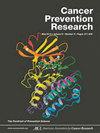BRCA1 和 BRCA2 携带者中幽门螺杆菌和胃肠化生的发病率
IF 2.6
3区 医学
Q2 ONCOLOGY
引用次数: 0
摘要
BRCA1 和 BRCA2 携带者罹患胃癌(GC)的风险可能会增加,但人们对胃癌发生的机制仍然知之甚少。我们试图确定 BRCA1/2 携带者中 GC 危险因素幽门螺旋杆菌(H. pylori)感染和胃肠化生(GIM)的发生率,以深入了解该人群中 GC 的发病机制。在 2022 年 3 月至 2023 年 3 月期间,100 名未经筛选的 BRCA1/2 携带者接受了内镜超声检查,并同时接受了上内镜检查和非靶向胃窦及胃体活检。研究对象(70% 为女性;平均年龄:60.1 岁)中有 66% 为 BRCA2 携带者。其中1人(1%)检测出幽门螺杆菌,7人(7%)患有GIM,2人(2%)患有自身免疫性萎缩性胃炎,未确诊GC。在 BRCA1/2 基因携带者中,幽门螺杆菌的感染率较低,GIM 的感染率与普通人群相似,但是幽门螺杆菌或 GIM 的鉴定可能有助于为 BRCA1/2 基因携带者未来的 GC 风险管理策略提供依据。本文章由计算机程序翻译,如有差异,请以英文原文为准。
Prevalence of H. pylori and gastric intestinal metaplasia in BRCA1 and BRCA2 carriers
BRCA1 and BRCA2 carriers may be at increased risk for gastric cancer (GC), however the mechanisms of gastric carcinogenesis remain poorly understood. We sought to determine the prevalence of GC risk factors Helicobacter pylori (H. pylori) infection and gastric intestinal metaplasia (GIM) among BRCA1/2 carriers to gain insight into the pathogenesis of GC in this population. 100 unselected BRCA1/2 carriers undergoing endoscopic ultrasound from 3/2022-3/2023 underwent concomitant upper endoscopy with non-targeted gastric antrum and body biopsies. The study population (70% women; mean age: 60.1) included 66% BRCA2 carriers. H. pylori was detected in one (1%) individual, 7 (7%) had GIM, 2 (2%) had autoimmune atrophic gastritis, and no GCs were diagnosed. Among BRCA1/2 carriers, H. pylori prevalence was low and GIM prevalence was similar to the general population, however identification of H. pylori or GIM may help inform future GC risk management strategies in BRCA1/2 carriers.
求助全文
通过发布文献求助,成功后即可免费获取论文全文。
去求助
来源期刊

Cancer Prevention Research
医学-肿瘤学
CiteScore
6.00
自引率
3.00%
发文量
173
审稿时长
1 months
期刊介绍:
Cancer Prevention Research publishes original studies, reviews, and perspectives in the field of cancer prevention. Its scope includes the molecular and cellular biology of premalignancy and early lesions; genetic and environmental risk factors; risk assessment and reduction; early detection research (cancer screening and diagnosis); and preventive interventions (chemoprevention, immunoprevention, and others) to intercept cancer development at early stages prior to initiation, promotion, or progression. The journal comprises preclinical, clinical, and translational research, with special attention given to molecular discoveries and an emphasis on building a translational bridge between the basic and clinical sciences.
 求助内容:
求助内容: 应助结果提醒方式:
应助结果提醒方式:


